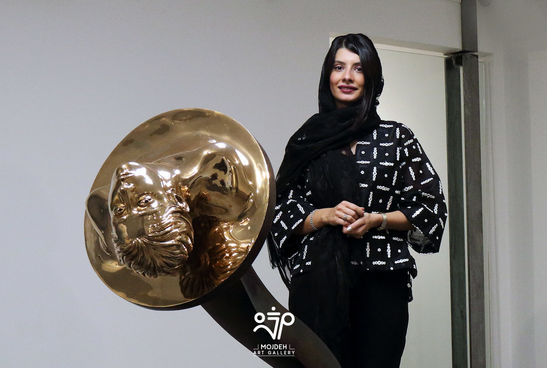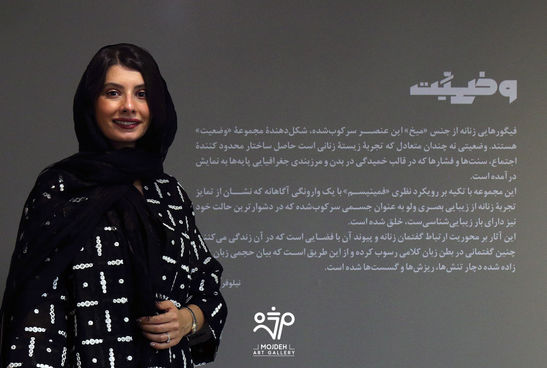The "Situation" is an Endless Silence that Still Continues...

The definition of a nail is: "A metal wire that has a sharp tip for digging in and a flat base for striking, and is used for connection and strength between two objects." The life of a nail depends on how it is used, if used by a skilled carpenter or craftsman, it can be useful, and if used clumsily by a novice, it will destroy the object. But in the "Situation" collection we have a distortion of this metal wire that has neither a tip to sink into nor a flat base to hit. These beautiful not-nails have connected many women to the earth and express a balance of the heterogeneity of the environment that casts a shadow on our lives. Women made of spikes that have been hit and dented, but are still firmly present, though toppled, and overturned.
It seems that the issue of the affectivity of the artist from the leading currents in art as well as the actions formed in the geography of her country has formed the theme of this collection. The feminism discourse in this work is a fundamental dialogue in the artist's thought, and in a second look, she refers to subtexts of continuous repressions and blames. The frankness of the dialogue-oriented expression of the artist, in balance with feminism globally and at this critical moment in Iran, is highly appreciated and pondered. Possession, domination and conquest of human beings are presented in this collection through an aggressive and militant concept called modernity. In the fundamental distinction between the realm of "freedom" and the realm of "compulsion", Kant calls nature the "realm of compulsion" and ethics the "realm of freedom". By expanding Kant's approach and through art, the artist calls into question the contradiction between compulsion and freedom in a fundamentalist society: a rational human being is hit by an invisible hammer and sinks into a swamp of anomality, and arrives at the meaning of "denying the centrality of man". Undoubtedly, people with nails as body and a human head also bring Marx's relations of production to mind, but not from the capitalist type, but from the dialectic of freedom and another's domination. This means isolated subjects that melt in the geography (the underlying maps of the artwork) and are placed in a one-sided interaction with the society, so that they reach an unbalanced bend. This decline can also be achieved through the process of social, cultural and economic interactions and lead the subject to invalidity.

In this collection, formalism is manifested to such an extent that it is as if the visual language of the sculptures themselves have formed a unique aesthetic and are integrated in the interaction with the content. At moments, like the figures, the viewer becomes unbalanced and bent to examine the works from different angles. This interaction between the work and the audience is an ideal example of the action that the sculptures provide and not only immerse the viewer in thought, but also form a physical encounter. The distorted figures captured by the nails are in a state of limbo, as if there is no way out, and they are in an unstable state. In this collection, the truth fluctuates in the reincarnation between existence and object.
According to Heidegger, to be human is to be in the world, and to be a woman in the collection of "Situation" is to be in fluctuation with the instrument of being a nail. Heidegger states that it is human interest and desire that connects us with things, such as hammer and pencil; When the carpenter is working in his workshop, the hammer is used to build something or repair something, and in other places the hammer has a different purpose. When someone is writing, the pencil is used to write something or make a calculation, and in other places, the pencil has a different purpose. The relationship of the carpenter with the hammer and the writer with the pencil is a zuhandenheit for specific purposes, which in the discussed work has become a fundamental relationship between the artist and the nailed object. "Situation" is a fundamental state that shows how every Iranian woman "is" and lives and expresses the lived experience of fear, anxiety, desires and hopes of women in Iran.
Also, referencing the nail to the human being suggests a meaningful relationship and slaughters the surrounding object in a violent awe of the human being. The nail, which is a handy object, finds a different existence in the structure of the sculpture and sinks into a specific geography. Female figures not only represent the relationship between humans and society, but also examine their relationship with their own existence. In the traditional society of Iran, this relationship has a meaning like the woman's body, that is, a bed of self-doubts and secrets and a taboo that is one of the taboos in the Islamic religion. Here, the artist presents a definition of "human being in the world" not as a free existence, but as a formal and usual presence that has a specific definition in any situation: living in a society full of violence, which turns into a nail-biting anxiety. The components of the artwork, such as a nail and a human being, which have an essential difference in a unified form, have formed a connected whole. Figures with a female head and a peg-like body sink into a place, although they are crooked, they are still alive and will continue to grow in an organic state. The dynamism and rotation of the form is a sign of the passion of life. In the "Situation" collection, the form of the human body is greatly simplified and through symbols, it provides a reference to the structures that have been assaulted on the body. A rough texture in combination with feminine softness reminds of the dual representation of the male gaze towards women. When facing the artwork, the audience follows a unified idea, as if insights are being formed in the figures. In these works, the identity follows an immediate and direct approach that examines the position of women in a geography that has always been involved in religious tensions.

Heidegger argues based on "existential analysis" that man is a temporal being, that is, he is always "still unfinished" before death. Here too, despite the fundamental static, the sculptures, through dynamic forms, instill the idea that they have an "unfinished" life; It is as if the figures are prophets who carry the news of a great event in the near future. The figures are sinking into the ground, meaning to come out of hiding and into the light. They are the tension resulting from the individual and the society, which is not only separated from the objectified world, but also in a close relationship with it: pious figures that express the difference between being seen and being, while they are behind the harshness of nature and environment, still in their existence, they have a composition of ecstatic and ritualistic feminine movements.
It is said that what passes through an artist's thought is not only her imagination, but also transitions in the dynamics of her society. By reasoning among many different events in society, the artist tries to present a different view through artistic aesthetics. A "Situation" is a set of different historical situations at the end of time; Where it begins with human existence and ends with a tool called modernism. The creator of this collection has managed to create subject-oriented objects, where it is as if a lotus flower has grown in the midst of a pile of dead objects. By denying the usual purpose of objects (nails) and common daily activities of men, she paradoxically questions their role in a violent society. The "Situation" collection is a portrait of a society that is about to be forgotten, which every moment exposes its memory.
Reza Latifi


